| Sound Mixer
HMP-288 |
(stylish toy keyboard with spectacular light effects & key
lighting) |
This big and noble looking toy tablehooter from 2004 (printed PCB/ CPU
date) has sample based sound and key lighting on the white keys. During
demos and rhythm it shows very impressive looking complex walking light
patterns in the style of a modern gambling or pinball machine demo mode.
But the lack of key matrix diodes prevent reliable polyphonic playability.
The impressive looking case is quite large; its 49 keys are even bigger
than normal midsize keys. Despite there are no audiogames, it has the same
strange flipping mechanism like the Potex
- Super Jam, but here it is poorly constructed and only makes the
case unstable and fairly wacky. The big illuminated center piece flashes
like a disco light in red, blue, pink and all intermediate colours and
constitutes the only drumpad of the instrument; it can be set to various
percussion and tekkno effect sound samples, and its center is a pseudo-
scratch disc that simply plays one sample per direction, but it not even
senses the direction correctly. The main voice has 10 preset sounds of
short looped medium resolution samples, those can be combined with a long
echo or slow vibrato effect. The 8 preset rhythms contain over- orchestrated
fixed key accompaniments, which makes them badly suited for melody play;
although the chord track can be muted, the bass track always keeps running
in its fixed key. The user interface is also in no way OBS but most functions
are cycled through by multiple presses of a single button, which makes
it badly suited for live performance. In unmodified state an annoying key
matrix flaw prevents reliable polyphonic play of more than 2 notes, and
the keys also respond a little slow, but this tablehooter is anyway rather
a spectacularly illuminated show object than a good instrument to play.
However with its slow howling vibrato it can at least make some nice pseudo-
analogue organ timbres those remind to my Tuttivox
tube organ.
The preset sound names are in wrong order and the control panel writing
is full of lies:
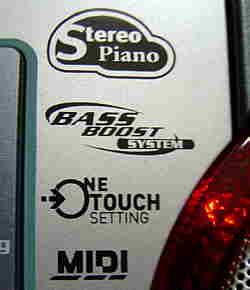 |
| "Stereo Piano" |
Genuinely the instrument is only mono. |
| "Bass Boost System" |
The bass reflex holes are fake and the speakers sound bassless. |
| "One Touch Setting" |
There are no OBS features. Possibly it means that a single buttons
cycles through multiple preset sounds or rhythms. |
| "MIDI" |
Hmmm... There is absolutely no MIDI jack anywhere. |
|
main features:
-
48 big midsize keys (a little wacky, flippable into 2x 24 keys, flats have
red key lighting)
-
2 built- in small speakers (mono, sound bassless and a bit distorted)
-
main voice polyphony 8 notes (only 2 with rhythm. Due to missing key matrix
diodes only 2 note polyphonic play is reliably possible.)
-
10 preset sounds divided into 2 groups with each 5 sounds:
-
inst. 1: {Piano, Vibraphone, Marimba, Hammond, Steel Guitar}
-
inst. 2: {Jazz Guitar, Finger Bass, Trumpet, Oboe, Clarinet}
(cycled through by each a single button)
-
8 preset rhythms {Pop, Slow Rock, Latin Rock, Jazz Waltz, Country, Boogie,
Bossanova, Samba} (cycled through by a single button)
-
"beat mode" button (a 9th rhythm that employs the normal ones as fill-in)
-
rhythms contain fixed key accompaniment (bass & chord voice; chord
voice can be muted)
-
volume +/- buttons (8 steps)
-
tempo +/- buttons (8 steps)
-
"echo" button {normal, echo, slow howling vibrato} (not combinable with
rhythm)
-
big illuminated drumpad
-
17 preset effect sounds assignable to the drumpad:
-
drum & cymbal: {base, snare, close hihat, cymbal, bongo, high conga,
low conga, timpani}
-
"sound effect" 1: {4 synth notes arpeggio, tambourin, bird tweet}
-
"sound effect" 2: {whistle pitchbend up, whistle pitchbend up, sproing}
-
"sound effect" 3: {fast scratch, rattling synth slap bass, fast synth scratch}
(cycled through by each a single button)
-
wannabe scratch disc (starts 1 sample per direction, ignores turning speed.
The sounds are taken from the same effect sound set like the drumpad sounds
and depend on the currently selected drumpad sound.)
-
main voice is made from short looped medium resolution samples with simple
volume envelope and few split zones. The envelope has a dose of zipper
noise. Percussion and effect sounds employ unlooped samples.
-
CPU= "HMP-211012-01, 2004.07.23" (34 pin COB module)
-
simple sequencer (record & play of 42 notes, no edit, quite useless
because contents is erased as soon anything but "play" is pressed).
-
key lights & speaker lights on/ off switches
-
8 demo melodies (complex arranged)
-
lesson & one key play mode (using the demo songs)
-
auto power- off (after 20s, also during rhythm)
-
no jacks
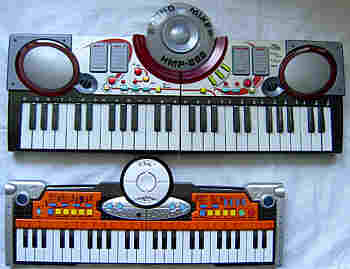 The
case is much bigger than Potex - Super Jam. The
case is much bigger than Potex - Super Jam. |
eastereggs:
-
When the instrument wakes up from standby mode (e.g. auto power off), the
main voice sound switches to "piano", but pressing certain buttons (e.g.
"stop") switches it back to the previously selected one.
-
The CPU has apparently 2 audio pins (AUD1, AUD2) marked on the PCB, thus
its internal sound output may be stereo.
notes:
The noble case design of this tablehooter looks quite unique and may be
inspired by the tekkno synth keyboard Yamaha DJX-II. Unfortunately
it has not much else common with that professional instrument nor it is
well suited for tekkno. The spectacular light effect feature of the Sound
Mixer HMP-288 was likely a direct successor of that on Yongmei
YM-238C, although the splendid walking light patterns here are
even more variable and remind to the demo mode of modern gambling or pinball
machines or the light bulb effects of certain old fairground orchestrions.
Unlike with Potex - Super Jam,
the strange case flipping mechanism of the HMP-288 apparently serves no
purpose and because it has neither a locking mechanism nor a stabilizing
plastic peg at the case front, it only makes the case mechanically unstable
and fairly wacky. Also the keys are a little wacky and the pretty metallic
buttons sometimes get stuck. By the lack of keyboard matrix diodes the
instrument often plays additional wrong notes when more than 2 keys are
pressed. (Soldering 48 diodes in would fix this.) Also the lousy working
scratch disc not only ignores turning speed, but even fails to recognize
the turning direction correctly, thus about every 3rd turn plays the sample
from the wrong direction or the drumpad. I remember that the Play
'n' Jam keyboard had a similar scratch disc flaw, which could be
fixed by soldering pull-up resistors to each of its matrix input lines.
The preset sounds are selected through group buttons those each cycle through
multiple sounds; all buttons beep or play the selected sound, which disturbs
live performance. The power off button on the control panel only switches
the instrument into standby, from where it comes up again by any key or
button press at fairly loud volume and "piano" sound. Also the auto- power
off switches it to standby already after 20 seconds. The real power switch
is on the case bottom and looks like the small "demo/ play" switch of various
Potex
toy keyboard. After power on, an arpeggio- like synth jingle of 4 fast
notes (same like the first sample on the first "sound effect" button) fades
louder and a tambourin fades quieter with a light pattern on keys, speaker
and drumpad, which has a quite micro$oftish appeal. By a bug the startup
jingle does not play when the scratch disc is rotated into a wrong position.
The lowest volume setting is still a little loud, and the sound distorts
already at medium volume. (I haven't examined the hardware closer yet.)
The preset sounds are made from short looped medium resolution samples,
those consist of a sampled attack phase followed by a short looped waveform
sample with simple volume envelope and no sustain, thus they stop immediately
after key release. The preset sounds are cycled through by 2 big group
buttons and despite the timbres are well recognizable, most sounds have
wrong names printed on them. The "piano" employs 2 key split zones. "vibraphone"
plays a trombone, "marimba" a slap bass. "hammond" sounds like expected
and plays a dull Hammond organ timbre, which sounds almost identical in
different octaves. "steel guitar" instead plays a vibraphone without vibrato.
"jazz guitar" plays an oboe, "finger bass" is a guitar (like intended?),
"trumpet" plays a dull e-bass (2 split zones), "oboe" a xylophone. "clarinet"
sounds like suggested. The "echo" button cycles through echo, vibrato and
normal sound. The echo restarts the envelope of any played note 7 times
and decreases the volume during each restart to approximate an echo. The
echo of each note clangs 5 seconds long and stays quite loud during the
first seconds, which tends to causes a cacophonic note cluster and thus
strongly limits its musical usability. The vibrato howls at slow 3Hz by
almost a full semitone, which sounds quite funny; with the "hammond" timbre
it sounds almost like my Tuttivox
tube organ, and also with "clarinet" it creates a nicely cheesy analogue
organ appeal.
Unfortunately there is only one drumpad to assign sounds to, and the
assign buttons always play their sounds during selection, which makes them
pretty useless for live play. Each drumpad sound also sets the 2 samples
for both directions of the scratch disc.
The rhythms always start at their default tempo and active accompaniment.
The accompaniment patterns are quite complex and over- orchestrated, and
they unfortunately play in a fixed key. Even when the chord voice is disabled
with its button, the fixed- key bass voice stays present, which makes them
almost useless for playing normal melodies, thus you can only improvise
to them. The highest tempo setting is ridiculously fast and also accelerates
the light effects to that speed, which can be used for tekkno, but without
key press the auto- power off throws a wrench into it after only 20 seconds.
The "beat mode" button does quite bizarre and barely useful stuff; it starts
a 9th rhythm, and each time the 'rhythm' select button is pressed, it selects
the next rhythm (as expected) but plays it only like a fill-in in the current
tempo and returns to the 9th rhythm after few bars. Also the "drum &
cymbal" button (that normally assigns drumkit sounds to the drumpad) cycles
through 3 fill- in accompaniment pattern in this mode. (I have no manual
of this thing, thus there might be still hidden features I don't know,
but with such wacky toy keyboards this is rather unlikely.)
The 8 demo melodies of this instrument are:
-
Old McDonald
-
Yoake
-
Yankee Doodle
-
Picnic
-
My Bonnie
-
Little Brown Jug [wrong melody]
-
Island Of Capri [same like "Ka-Bu-Le Island" on Elta
KE-6]
-
Jingle Bells
The demo musics are complex arranged with a lot of cartoon- style effect
noises. They are also used by the key lighting feature. Press the 'lesson'
button to start it; although the key lighting makes the correct key flash
first and stops flashing after a while, the timing of this change is completely
wrong and far too slow to indicate the correct timing to play notes. The
next key always flashes as soon the previous was pressed, and the accompaniment
track of the song repeats in a loop until the correct key is pressed. In
any key play mode (press 'OKON' button) the instrument behaves similar,
with the difference that now any key presses steps through the melody.
| removal
of these screws voids warranty... |
|
|
 |

|
|
| |
back
|
|
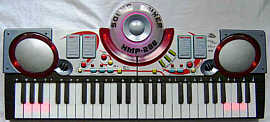
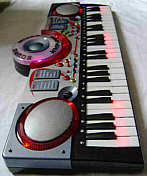


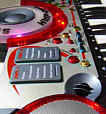
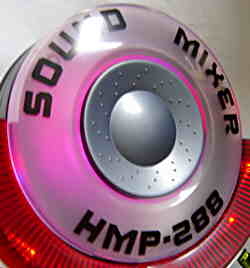
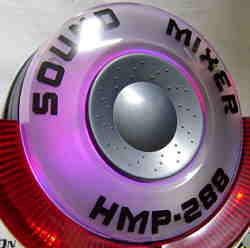

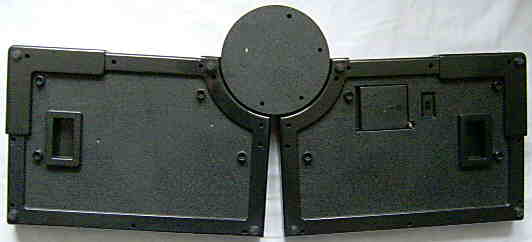
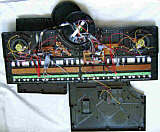
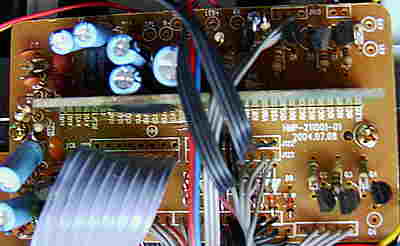

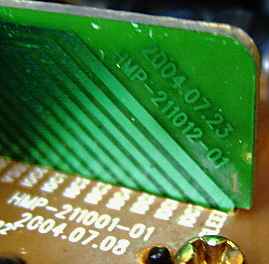
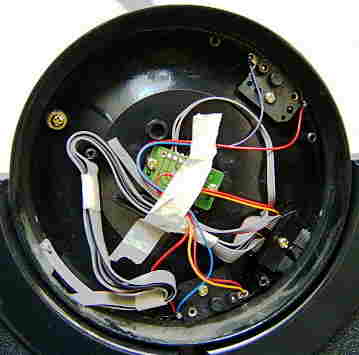
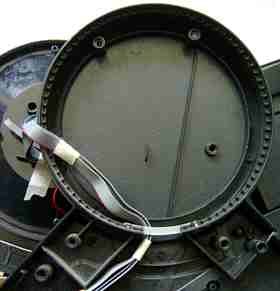
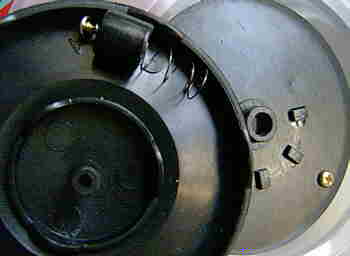
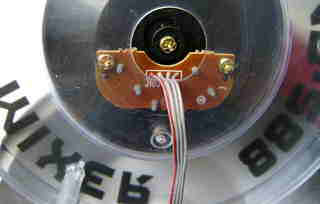
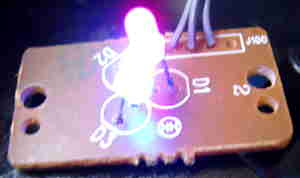
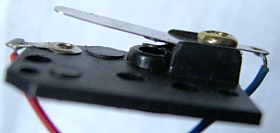
 The
case is much bigger than Potex - Super Jam.
The
case is much bigger than Potex - Super Jam.